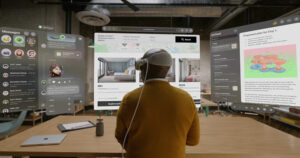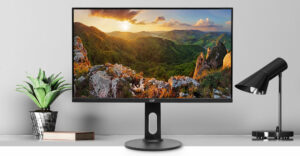
I spent much of last week in Brazil watching five South American University teams show prototypes of their ideas on what the majority of the world needs in personal computing hardware and services.
In addition, last week Congress once again went after HP — but this time seemed to step in front of the Securities and Exchange Commission on an issue that appears to have been vetted (so it looks like abuse of power to me). Finally, Forrester released a survey showcasing the “catastrophic” drop in iTunes sales, prompting speculation on whether Apple is, once again, on a downward spiral (it isn’t).
AMD Changing the World
The AMD50×15 initiative is one of those rare things where corporate financial goals and humanitarian goals appear closely aligned. With under 15 percent of the world population able to use the Web, there is a massive number of people who could benefit from knowledge they simply can’t get to. This initiative is to get PC like devices to 50 percent of the population by 2015.
The event was theChange the World contest, and I was honored to be one of thejudges flown in to evaluate the entries.
What really struck me as different, in terms of approach, was that the contest entries were cross-discipline, varying widely from each other as a result. With some, you could see a heavy engineering focus, which is more similar to what I’m used to from hardware companies. However, two in particular focused extensively on social engineering to create systems that could significantly help reach the 50×15 goal.
There were five finalists. This is how I’d rank them in reverse order:
No. 5: Eco Red
The Eco Red was perhaps the most audacious — and also probably missed the mark by the greatest degree. It was a projector PC, watertight and wireless, with a touch screen and waterproof case. Estimated cost by the team was roughly US$350, but the annual income of the target — fishermen — wasn’t much more.
It would have made a really interesting Media Center-like product for the developed world, but it was both too complex and too expensive for the target, and the thermal/reliability problems of putting a digital projector and PC in the same watertight case would have been daunting.
Still, it had an interesting aquatic industrial design and was actually rather attractive. The team didn’t seem to really understand the target market, and this is a common mistake even with mature companies.
No. 4: Fly Tech
This was a cool mini-laptop with a fold-flat screen and a joystick pointing device. Targeted at students in emerging markets, it would come in multiple colors — and the mock-up was very nicely done.
It had two fundamental problems: The higher-education students targeted generally have computer access now, so it didn’t really move the 50×15 bar much, and the team hadn’t studied existing laptop design so that they could avoid mistakes other builders have made — like using unique and generally overly costly pointing devices.
In short, they basically built a PC for themselves — but I doubted whether, when given a choice between what they designed and a real PC for less money, they would have actually purchased it if they had not built it.
Building for yourself is a good thing, though, and this was successfully demonstrated by theFlybook (note the similar name), which has been very successful in Europe.
No. 3: Cricket (Interaction in Movement)
Now I wanted to play with this. Clearly the most advanced of the presentations, this product looked like things I’ve seen from Frog Design and Apple over the years. Targeted at tourists, it was about the size of two PDAs (personal digital assistants) and had two displays, including one that slid out. It was designed for location-based services.
I actually thought this was the most commercially interesting, because it could be used as part of tours and cruises to get travelers to stores they wanted to visit and could pass back substantial revenue to the tour owners and cruise lines if implemented properly.
It was the closest thing I’ve seen to a Google model in hardware. If this had been a pure design competition, it probably would have won hands down — but the team targeted tourists, and that really didn’t address the 50×15 problem, so they didn’t win but they sure impressed us a lot.
No. 2: Gota
In terms of hardware, this was the lightest — but in terms of social engineering, it was the most advanced. This won the $30K chairman’s award.
Hardware was a custom case mini-tower and not particularly interesting — though it did run, and cost was likely under $300. However, the team based the business model on an existing social trust structure that had been successfully operating for years bringing water to remote groups.
By using an existing social structure that operated successfully on trust, they were able to bypass the theft problems that Microsoft’sFlexgo had to be designed to address.
Overall, this effort showcased the massive advantage of a cross-discipline approach to the problem, resulting in a unique and potentially very powerful solution.
No. 1: E-Cipo
This product was probably the least attractive product of the bunch, but it was the most closely targeted at the design goals for the contest.
Costing around $100 in volume, using a TV and cell phone to display and communicate (both are actually widely deployed in emerging markets), and connecting to a university-sourced custom portal, this became the natural winner of the $30K judges award and took first place.
The design, while not as edgy as others, fit the culture and use model for the target, and it was relatively robust and incredibly easy to set up. The keyboard could have used some work, and it used a track ball, a pointing device that typically would not hold up well in the target market, but these hardware problems were insignificant against what was the most complete and balanced solution presented.
It made me wonder if Microsoft had thought thatMSNTV (WebTV) might actually be a better solution than Flexgo for the emerging markets; certainly both the students — it also won the student award — and the judges thought so.
Overall, this showcased the power of getting location experts, people experts and engineers to work on location-focused products, and I left the event feeling that there should have been one or two OEMs (original equipment manufacturers) there to observe the process and the result. Doing this right could be core to their success in emerging markets.
HP and Government Power Abuse
As I was returning from Brazil, I got a press call asking me about Congressgoing after Mark Hurd for stock trading irregularities.
This seemed really strange, because Hurd’s personality and behavior (he isn’t money- or fame-focused, and is very detail-oriented) don’t lead to a conclusion that he would be likely to make an insider trading mistake.
I then went up on Google forbackground and found that, according to the Mercury News, the questions being asked had been addressed back in October, and it appeared Congress already had what it wanted. Since the SEC, which has been very aggressive of late, hadn’t acted, it looked like this was a nonissue.
Why would the subcommittee of the House Energy and Commerce Committee be looking at insider trading? And why would it pointlessly send out a memo asking things that had already been answered — particularly given that it could do damage to HP, one of the most successful companies in the tech market?
More importantly, it makes Hurd look guilty even though it appears the committee members already know he is innocent. He isn’t running for office, so why character-assassinate the guy?
What this looks like to me is that members of this group want to make a statement that there is a new sheriff in town that isn’t business-focused, or they want to make sure Hurd never runs for office. However, going after someone that you appear to know didn’t do anything wrong just to make a statement is an abuse of power.
Given that we already have a problem with tech companies moving oversees, and the old Congress clearly had a power abuse problem, this new Congress doesn’t appear to be starting well.
This just confirms my belief that here in the U.S., politicians may be our biggest problem — and that you sure as hell don’t want the same party controlling both the legislative and executive branches of government when their power corrupts them.
Apple’s Collapse
Forrester has to be having a fun weekhearing from the Apple fans after it announced that iTunes music sales had “collapsed,” dropping 65 percent. Apple makes little or no money on iTunes music, but this music forms a switching cost barrier that prevents other MP3 products from cannibalizing existing Apple customers.
In short, if you want to switch, you have to kiss off all your purchased tunes and then buy them again from someone else.
If fewer and fewer people buy music this way, this barrier gets weaker over time. That could be problematic for Apple, which is facing ever more-focused competitors.
Personally, I think this simply means that folks are realizing what a rip-off DRM (digital rights management)-protected downloaded music is, and they are going back to CDs so they can do what they want with the music they purchase.
In other words, buyers are getting smarter — and any market can benefit from smarter buyers, because it generally results in better products.
The bigger warning may be for the RIAA (Recording Industry Association of America): This may also indicate that buyers are getting fed up with how difficult it is to use downloaded music legally, and they want to stop funding an organization that treats music lovers as criminals.
Rob Enderle is a TechNewsWorld columnist and the Principal Analyst for the Enderle Group, a consultancy that focuses on personal technology products and trends.






















































Or, you can simply burn your purchased iTunes songs to up to five CD’s and keep them as long as you like.
Also, the Forrester report about the ITMS is open to some serious questions.